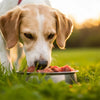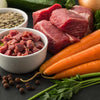How to Make Your Own Raw Dog Food at Home: A Comprehensive Guide for Pet Lovers
- Houndsy
Table of Contents
- Introduction
- Understanding the Raw Dog Food Movement
- Step-by-Step Guide to Making Raw Dog Food
- Safety Precautions
- Additional Raw Food Recipes
- Integrating Raw Food with Kibble
- Monitoring Your Pet's Progress
- Conclusion
Introduction
Imagine your furry friend bounding into the kitchen, tail wagging at lightning speed, eagerly anticipating mealtime. As devoted dog owners, there's nothing quite like the satisfaction we feel when watching our pets dive into a delicious and nutritious meal. In recent years, many pet owners have turned to raw dog food diets, citing reasons ranging from allergies to health problems associated with commercial kibble. According to a survey by the American Pet Products Association, approximately 33% of dog owners believe that a raw diet provides better health benefits for their pets. This shift towards raw diets has made it imperative to understand how to make your own raw dog food at home.
In this blog post, we will explore the ins and outs of creating balanced raw dog food. By the end, you'll learn everything from the nutritional needs of dogs to step-by-step recipes you can use right away. We will also share tips on ingredient selection, safety measures, and how to incorporate our flagship product, the Houndsy Kibble Dispenser, for storing any leftover kibble if you choose to mix raw with dry food.
We'll dive into the topics surrounding raw dog food in detail while maintaining a conversational tone, providing you with actionable steps you can take to elevate your dog’s feeding experience and ensure their health.
Understanding the Raw Dog Food Movement
The Case for Raw Dog Food
The raw dog food movement is grounded in the idea that pets thrive on a diet closer to what their ancestors, the wild canines, would have eaten. Many proponents argue that raw diets can lead to better digestion, healthier skin and coat, improved dental health, and higher energy levels. With reports from dog owners and veterinarians alike supporting the benefits of a raw food diet, it’s no wonder that this topic has gained so much traction.
Nutritional Needs of Dogs
Understanding the nutritional needs of dogs is crucial for crafting a balanced raw dog food recipe. Dogs are classified as omnivores, which means they require a combination of meat and plant-based foods to thrive. A typical raw diet should consist of:
- 70-80% Animal Protein: This includes muscle meat, organ meat, and bones.
- 10-20% Vegetables and Fruits: While not essential, small amounts can provide fiber and additional nutrients.
- 5-10% Healthy Fats: This includes healthy oils and animal fats.
Dogs rely on these nutrients to maintain proper health, avoiding deficiencies while ensuring they receive a balanced diet.
Preparing for Raw Dog Food
Before creating your dog's raw food, it’s essential to prepare. Here’s what you’ll need:
- Quality Ingredients: Sourcing high-quality, human-grade meat is paramount. This may include beef, chicken, turkey, lamb, and fish.
- Measuring Tools: Accurate measurements are vital to ensure a balanced diet.
- Mixing Equipment: A large mixing bowl and a cutting board will serve you well in this preparation process.
- Storage Containers: Air-tight containers to store leftover food or pre-portioned meals.
- Cleaning Supplies: Don't forget antibacterial cleaners for safe food prep areas.
By ensuring that you have all the necessary equipment before starting, you can streamline the process, making it enjoyable and safe.
Step-by-Step Guide to Making Raw Dog Food
Creating homemade raw dog food may seem intimidating at first, but breaking it down into manageable steps makes it straightforward. Here’s a simple recipe to get you started:
Basic Raw Dog Food Recipe
Ingredients
- 3 lbs ground beef (or chicken if preferred)
- 1 lb chicken livers (optional but highly nutritious)
- 1 cup carrots, chopped
- 1 cup spinach, finely chopped
- 1 cup blueberries (for antioxidants)
- 2 whole eggs (with shells crushed for calcium)
- 1 tablespoon olive oil (for healthy fats)
Instructions
- Prepare the Chicken Livers: Rinse the chicken livers under cold running water to remove any impurities. Chop them into small pieces.
- Chop Veggies: Use a food processor to finely chop carrots and spinach. This step is important for making nutrients digestible for your dog.
- Combine Ingredients: In a large mixing bowl, combine the ground beef, chopped livers, carrots, spinach, blueberries, crushed eggs, and olive oil. Mix thoroughly to ensure even distribution of ingredients.
- Portion and Store: Divide the mixture into meal-sized portions and store in airtight containers. You can freeze any portions that won’t be used within three days.
- Serve: Thaw meals in the refrigerator overnight before serving them to your dog.
How to Adjust Recipes for Individual Needs
Every dog is unique, and their dietary needs may vary based on factors like size, age, and activity level. It’s essential to adjust the ingredient ratios so that they meet your dog’s specific needs. For larger dogs, you may choose to increase the protein content. For dogs with allergies, experiment with different protein sources while keeping track of their reactions.
Safety Precautions
When working with raw ingredients, there are several safety measures to keep in mind:
- Hygiene: Always wash your hands, utensils, and work surfaces before and after handling raw meat. This helps prevent cross-contamination.
- Storage: Store raw dog food in the fridge or freezer. Make sure to consume thawed food within three days to maintain freshness.
- Supervision: Monitor your dog while they are eating to prevent any choking hazards, especially with bone content.
Handling raw dog food carefully and prioritizing your dog’s safety can ensure a fulfilling feeding experience.
Additional Raw Food Recipes
While the basic recipe is a great starting point, we encourage creativity as you become more comfortable with the art of making raw dog food. Here are two additional recipes that maintain balance while offering variety:
Recipe 2: Turkey and Sweet Potato Delight
Ingredients
- 4 lbs ground turkey
- 1 cup sweet potato, cooked and mashed
- 1 lb chicken heart or gizzards
- 1 cup green beans, chopped
- 1 tablespoon fish oil
Instructions: Combine the ground turkey, sweet potato, chicken hearts, and green beans. Mix well and portion accordingly.
Recipe 3: Fish and Vegetable Medley
Ingredients
- 2 lbs salmon (boneless)
- 1 cup kale, finely chopped
- 1 cup carrots, shredded
- 1/2 cup pumpkin puree (not the spiced pie filling)
- 2 tsp ground flaxseed
Instructions: Blend all ingredients together and serve fresh or frozen.
Integrating Raw Food with Kibble
As you embark on making your own raw dog food, you may still wish to incorporate kibble into your dog's diet. This is perfectly acceptable and can provide more variety in meals. If you do, consider utilizing the Houndsy Kibble Dispenser to store your dry food. Our dispenser ensures that you have the perfect portion control every time you need to refill your dog’s bowl, simplifying your routine and minimizing mess.
Monitoring Your Pet's Progress
Once you start feeding your dog homemade raw food, it’s vital to observe any changes in their health. Watch for:
- Energy Levels: Increased energy is often reported by pet owners switching to raw diets.
- Coat Shine: A shiny coat typically reflects overall health.
- Digestive Health: Watch for firm stools, reduced gas, and improved digestion.
Consulting with Your Vet
Before making significant changes to your dog’s diet, we recommend having a conversation with your vet. They can provide tailored advice based on your dog's unique health considerations, and guide your efforts to ensure a nutritionally balanced diet.
Conclusion
The journey into raw dog food preparing is exciting and empowering. Not only does it provide an opportunity to connect with our pets through the meals we prepare, but it’s also a commitment to ensuring they receive the best possible nutrition. As we’ve discussed, the core of successful raw dog food involves understanding your pet’s needs, sourcing high-quality ingredients, and maintaining safety throughout the preparation process.
Are you ready to elevate your dog’s feeding experience? Explore the versatility of the Houndsy Kibble Dispenser to complete your feeding routine while maintaining a balance between raw and dry food (Order Now: Houndsy Kibble Dispenser). Remember, your dog’s health is an ongoing journey, and making informed choices can lead to a happier and healthier companion.
FAQ
Q1: Can I substitute different meats in the raw dog food recipes?
Yes! Dogs can thrive on a variety of protein sources. Feel free to experiment with meats like lamb, chicken, turkey, or fish. Always consider your dog’s allergies and preferences.
Q2: How much raw food should I feed my dog?
A general guideline is to feed about 2-3% of your dog’s body weight daily in raw food. For example, a 50-pound dog would require 1 to 1.5 pounds of raw food per day.
Q3: Is it safe to feed dogs raw bones?
Raw bones can be safe if administered properly. Avoid cooked bones, which can splinter. Always supervise your dog while eating bones and consult with your vet for specific recommendations.
Q4: How do I transition my dog to a raw diet?
Start by mixing a small amount of raw food with your dog’s current diet. Gradually increase the proportion of raw food over several days, while monitoring your dog's digestion and any reactions.
Q5: What nutrients should I add to raw dog food to ensure it's balanced?
Incorporating a small amount of organ meat, such as liver, is beneficial. Additionally, consider using eggs, oils, and occasional supplements like fish oil or seaweed for extra nutrients.
Q6: Can I still use commercial kibble alongside homemade raw food?
Absolutely! Mixing raw food with high-quality kibble can diversify your dog’s diet. Just be sure to monitor portion sizes to avoid overfeeding. The Houndsy Kibble Dispenser can help you portion your kibble perfectly for every meal.
Embarking on the raw dog food journey opens a world of possibilities for enhancing your pet's health. Enjoy the process as you delve into the joys of homemade dog food, knowing that every meal plays a part in your dog’s well-being.












